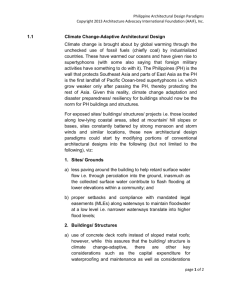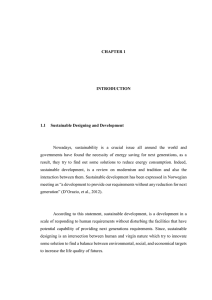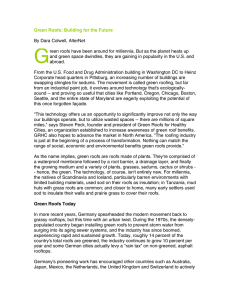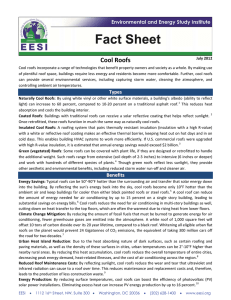Architecture & climate - Cal State LA
advertisement
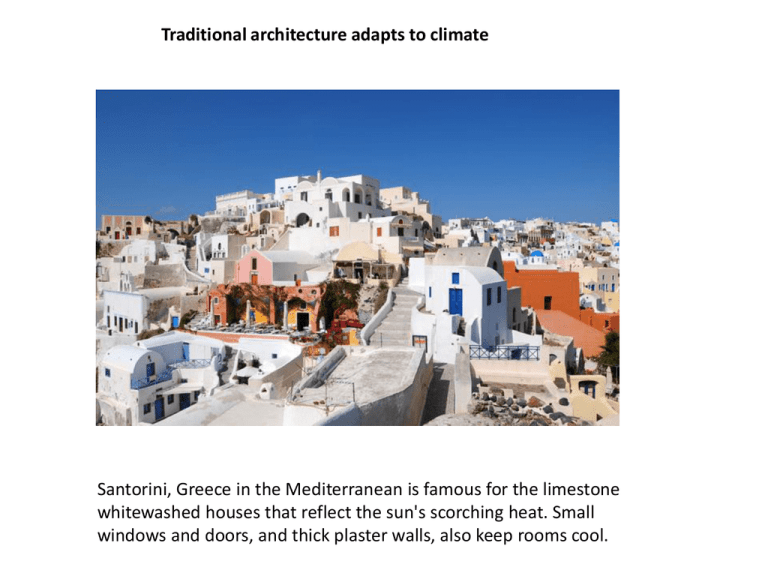
Traditional architecture adapts to climate Santorini, Greece in the Mediterranean is famous for the limestone whitewashed houses that reflect the sun's scorching heat. Small windows and doors, and thick plaster walls, also keep rooms cool. Sheikh Zayed mosque in Abu Dhabi. Domes or vaulted roofs allow hot air to escape from floor level and expose a larger surface area to the night sky, allowing the heat built up during the day to radiate out better than a flat roof. Domes expose a smaller area to the sun during the hottest part of the day when the sun is directly overhead. Whitewashing also helps to reflect heat away from the faithful inside. (Source: Reuters) The number one priority in the Arctic is keeping warm. The Inuit peoples responded with the igloo. Made from blocks of wind packed ice, the low profile, domed shape, and narrow entrance protects the structure from wind erosion and keeps snow out. But the genius of the igloo is the insulation provided by the snow. The temperature inside can be more than 30 degrees Celsius higher than the outside temperature and get as high as 15 degrees Celsius. (Source: Shutterstock) Japan's alpine valleys receive some of the heaviest snowfalls in the world. Therefore traditional 'gassho-zukuri' (clasped-hands) homes have high, steeply-peaked roofs so the snow (and rain) can easily slide off the roof thatched from local grasses and straw. This not only prevents collapse but also avoids leaks and rotting. The high roof also serves as a kind of chimney for the stove inside. A Mongolian boy stands against a ger or yurt, a traditional portable house used by nomadic peoples in the Central Asian steppes. A circular wooden lattice frame is covered by felt mats made from the wool of sheep, goats or yaks that the nomads herd. These mats can be removed or rolled up in summer to let air flow through the ger. The lattice frame keeps animals out. The circular shape leaves the least amount of exterior surface exposed making it easier to heat and protect against the strong winds. A house with a traditional grass roof in the Faroe Islands in the stormy North Atlantic. A grass roof with a layer of turf underneath provides great insulation, and keeps the house nice and quiet. It also prevents excessive rainwater runoff and because the soil soaks up the water grass roofs are often less leaky. What's more, because the roof is alive it is soaking up carbon dioxide. Children from Indonesia's Bajo tribe near their pole house in Sulawesi province. Away from the dense vegetation onshore, pole house are less humid and can catch the slightest breeze to help ventilation through the walls and floor. Water radiates heat less strongly than land for most of the day. Raised high above the water surface they also protect against floods, dampness, and animals. Gabled roofs shed the heavy rain common in tropical regions. Muslims wash in the fountain waters inside Kashmir's Jamia Masjid mosque in Srinagar. Courtyards help ventilate surrounding buildings by circulating air which is cooled by overhanging verandas, cloisters, and other shaded areas. They also distribute light. Water features like ponds or fountains take heat out of the air by evaporation while vegetation acts as another coolant while also freshening the air quality. Islamic architecture is renowned for its intricate and exquisite detail, but lace-like screens and lattices also reduce glare from the sun, provide shade, and help ventilate buildings by allowing breezes to waft through walls. Traditional Pueblo homes are built from natural adobe bricks-pressed layers of dirt or clay- and locally-gathered grasses such as straw. Outside, they are coated with a layer of mud. Thick, blank walls with few windows moderate the temperature inside. The roofs are flat and make use of spouts to deal with rain, the mud cover protects the inhabitants from the elements. The ancient Moroccan city of Fez has a walled old town, or medina, that features massive buildings, narrow streets, courtyards, and shuttered doors and windows. All are designed to provide shade and funnel breezes through the area. These features have evolved over time from the desert cave and cliff dwellings that provided similar shelter from the heat and desert winds. Large sliding doors-shoji-allow natural light and cooling air to stream through a Japanese tatami room. Many such rooms have doors in opposite walls to promote ventilation in this humid climate. The doors are easily adjustable to allow in as much light and air as required. The tatami floor, meanwhile, is woven from grasses and reeds, while the doors are made from rice paper and wood. A five story pagoda in Miyajima, Japan. Japan is famous for its earthquakes, yet only two of these five-story pagodas have been flattened by tremors in over 1000 years. Made from wooden beams, pegs and wedges, pagodas also have adobe filling between the wooden supports. When the pagoda sways, the adobe slowly crumbles and absorbs the seismic shockwave. Meanwhile, the heavy roof tiles fall off, lightening the load on the rest of the building. When the earthquake stops, all that needs to be done is to replace the missing roof tiles and replaster the crumbled infilling. Malaysia tropical architecture So. American straw hut. Amerindians built tent like huts made from palm fronds with cone shaped roofs. Structural plans were circular and approximately 14 feet in diameter. Materials such as wild cane, rush, and bamboo were also used. Although quite simple in structure, the huts with stood strong winds and even hurricanes. There is another way to have natural ventilation circulating through the building and this can be done by humidity, known as cool tower or most commonly by temperature through a stack or Venturi effect.[4] Cooler air, being denser, will enter from openings lower down the building and the success of this system is dependent upon the volume of air it moves through the building. The higher the stack, the greater the flow, a fact which can be seen in traditional and vernacular buildings where this method has long been used. Sources: Traditional architecture http://knowledge.allianz.com/environment/energy/?633/sustainable-shells-arevolution-in-construction 13 slides of native architecture adapted to climate Climate-architecture of Malaysia http://www.slideshare.net/namanlochan/equitorial-climate Caribbean architecture http://ufdc.ufl.edu/AA00004342/00001/20j Middle East traditional architecture http://link.springer.com/chapter/10.1007%2F978-3-540-75997-3_508#page-1







